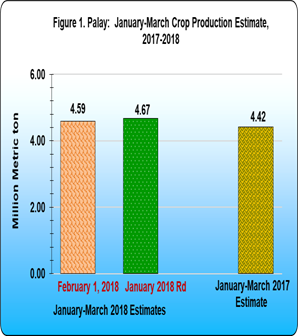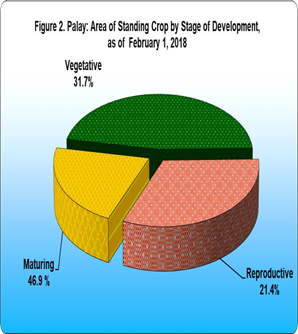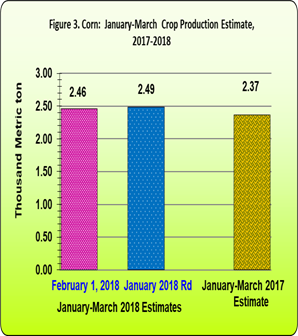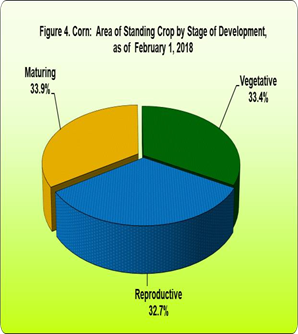Updates on April-June 2024 Palay and Corn Estimates Based on Standing Crop, 01 June 2024
HIGHLIGHTS
Based on standing crop as of February 1, 2018, the updated January-March 2018 production estimates on palay and corn may decline from the January 2018 Round estimates.
The probable drop in output may be attributed to the effects of typhoons Urduja and Vinta and occurrence of rains during the reproductive and maturing stages of the crop.
PALAY
- The probable palay production for January-March 2018 based on standing crop as of February 1 2018 may decline to 4.59 million MT, 1.70 percent lower than the January 2018 round estimates of 4.67 million MT. On the other hand, this may be higher by 3.8 percent from the previous year’s output of 4.42 million MT (Figure 1). Harvest area may contract by 547 hectares from the 1,192.53 thousand hectares. Yield may decline to 3.85 MT per hectare from 3.92 MT level.

- The possible factors contributing to the decrease of palay output may be due to:
- effects of typhoons Urduja in Capiz and Vinta in Zamboanga Norte and Zamboanga Sibugay last December 2017;
- lower yield in Mindoro Oriental and Leyte resulting from occurrence of rains during the reproductive and maturing stages of palay; and
- rice bug infestation in Tarlac and Iloilo.
- Almost 223.78 thousand hectares or 18.77 percent of the updated standing crop have been harvested. As to the farmers’ planting intentions for the April-June 2018 crop, about 619.52 thousand hectares or 68.1 percent of the perceived harvest area have been actually planted.
- Of the 1,587.73 thousand hectares standing palay crop, 46.9 percent were at vegetative stage; 31.7 percent, at reproductive stage and 21.4 percent, at maturing stage (Figure 2).

CORN
- The probable corn production for January-March 2018 based on standing crop as of February 2018 may decline to 2.46 million MT, 0.9 percent lower than the January 2018 round estimate of 2.49 million MT. On the other hand, this may be higher by 4.1 percent from the previous year’s output of 2.37 million MT (Figure 3). Harvest area may decline by 0.10 percent from the 720.21 thousand hectares level. Likewise, yield per hectare may drop to 3.42 MT per hectare from 3.45 MT per hectare.

- The possible decrement in corn output may be attributed to:
- effects of typhoon Urduja in Cebu and Vinta in Zamboanga Sur and Zamboanga Norte;
- planthopper infestation in Ifugao; and
- continuous rains in Isabela, Negros Oriental and South Cotabato which affected plant growth at reproductive and maturing stages.
- About 150.81 thousand hectares or 20.9 percent of the updated standing crop have been harvested. Around 219.78 thousand hectares or 54.8 percent of the planting intentions of the farmers for the January-March 2018 have been realized.
- Of the updated 764.81 thousand hectares of standing corn crop, about 33.4 percent were at vegetative stage; 32.7 percent, at reproductive stage and 33.9 percent, at maturing stage (Figure 4).

ROMEO S. RECIDE
Assistant Secretary
Deputy National Statistician Sectoral Statistics Office
Technical Notes
Production refers to the quantity produced and actually harvested for a particular crop during the reference period. For palay and corn, harvest area refers to the actual area harvested/to be harvested during the reference quarter.
Updates on production and harvest area estimates of palay and corn are generated from the Monthly Palay and Corn Situation Reporting System (MPCSRS). It is a monitoring activity conducted monthly in-between Palay and Corn Production Survey (PCPS) rounds. Monitoring are conducted in February, March, May, June, August, September and November. MPCSRS updates the quarterly estimates on production and area for the current quarter based on the PCPS results of the previous survey round.
The data generated from MPCSRS are as follows:
1. Updates on current quarter’s production and area estimates based on the standing crop with indications on crop situation; and
2. Updates on current quarter’s estimates on planting intentions based on actual plantings.
